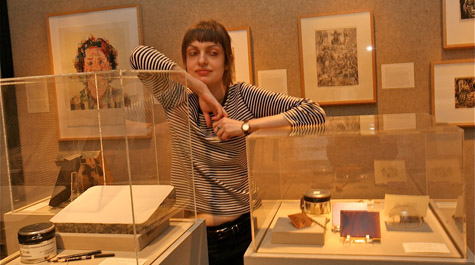Printmaking at W&M: where metal meets metal
Her love for the art of printmaking and her particular specialty in etching and engraving is also what led her to become one of the student curators for the new “Mediated Image: Techniques in Printmaking” exhibit at the College’s Muscarelle Museum of Art.
“I enjoyed doing it, because the goal of the show is teaching printmaking, and I’m very passionate about it,” Wagner said about her experience as a printmaking curator. “I want to be a part of a tradition and inspire other people in the practice.”
The exhibit, currently showing at the Muscarelle until April 11, showcases four major techniques of printmaking and the intricate, labor-intensive processes by which each print is produced.
“We wanted to suggest the range of possibilities of each media and show how they were ongoing and how they started at a certain point and how the same techniques are used today,” said Art History Professor Catherine Levesque.
The exhibit, which displays the four printmaking media of woodcut, engraving, etching, and lithography, was organized by Levesque’s “History of Prints” senior seminar class as part of a semester-long project. William & Mary students, in a sense, took the role of an art museum curator as they chose works of art but at the same time had to be conscious of the overall theme of the exhibit and indirectly showing the in-depth process required to make a print.
“Basically, they did everything they had to do for an exhibition, they chose the works, they did the research, wrote the labels, and worked out how things were going to be arranged,” Levesque said.
Works on display, all of which are original masterpieces, range from prints by 17th century artists such as famous etcher Rijin Rembrandt to more modern works such as those of Kathe Kollwitz, who experimented with each medium of printmaking. The collection also features two works in color along with several prints originally made for books. Most of the works themselves were donated to the Muscarelle Collection by College alumni and professors while others were obtained through the Muscarelle Museum’s acquisition fund.
Levesque also said that the art of printmaking itself arose out of a need to mass produce. Whereas paintings on a canvas can only be done once, with printmaking, multiple prints can be produced at each step or ‘state’, thus revealing small differences that an artist believed needed to be changed.
“The idea is you take one thing and you keep changing it,” Levesque said, “If you go back to the plate, you could have a record of an artist’s entire thought process.”
Unlike painting, in printmaking, the artist must take into account the fact that his work will be printing in reverse. In addition, because of the nature of printmaking, the artist must also undergo several extra steps in the form of prep work before beginning to draw.
“It has to be worked out mathematically where everything needs to go,” Levesque said. “There is a technical tour de force that over time, there are several similarities and differences that artists keep looking back and learning from.”
Today, printmaking can be seen as an art that is becoming more respected in its aesthetical form. Although most prints today are digitized, artists still have a sense that one must learn traditional methods in order to understand the present.
“I think there’s a sensibility that probably the best graphic designers have some experience with printmaking,” said Levesque, “You experience tonalities differently, you experience putting something together differently when you have to go through these processes. Within fine arts, most artists who like to draw like to do prints. It’s experimental; you can keep tinkering with your work.”
For Wagner, tradition plays a huge role in her decision to become a professional printmaker. Using tools that her grandfather and father, both engravers, once used, she continues to etch her masterpiece into copper stroke by stroke.
“I get to draw what I love best with printmaking. It was a clear choice,” Wagner said.
In the future, she hopes to become an art professor specializing in printmaking.
Her current work in progress, an image of “printmaking in exile,” is the first in a series on the emotional history of printmaking. So far, she has spent the better part of two months working on the debut piece. When finished, she expects to have made seven different ‘states’ of her work, each one adding on more detail and complexity, along with fixing the deficiencies of the one before it.
“Failure is so much a part of printmaking,” Wagner said. “But when it works, it’s worth it.”
















